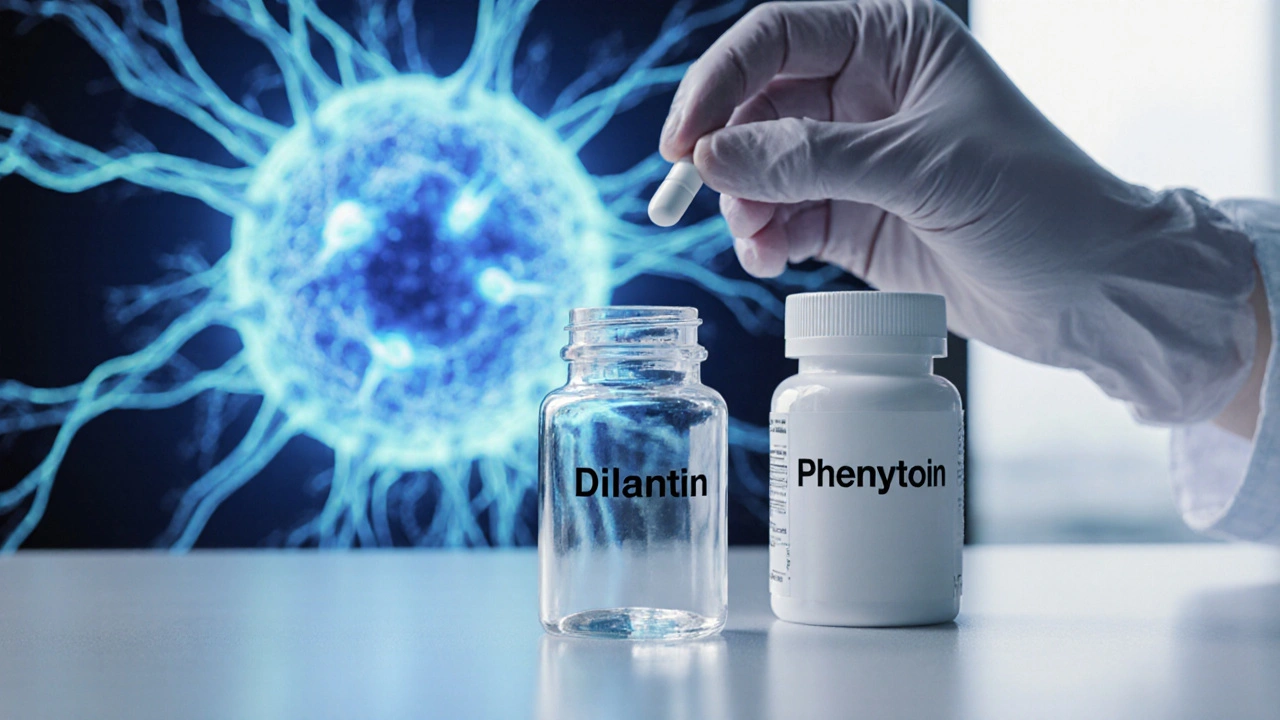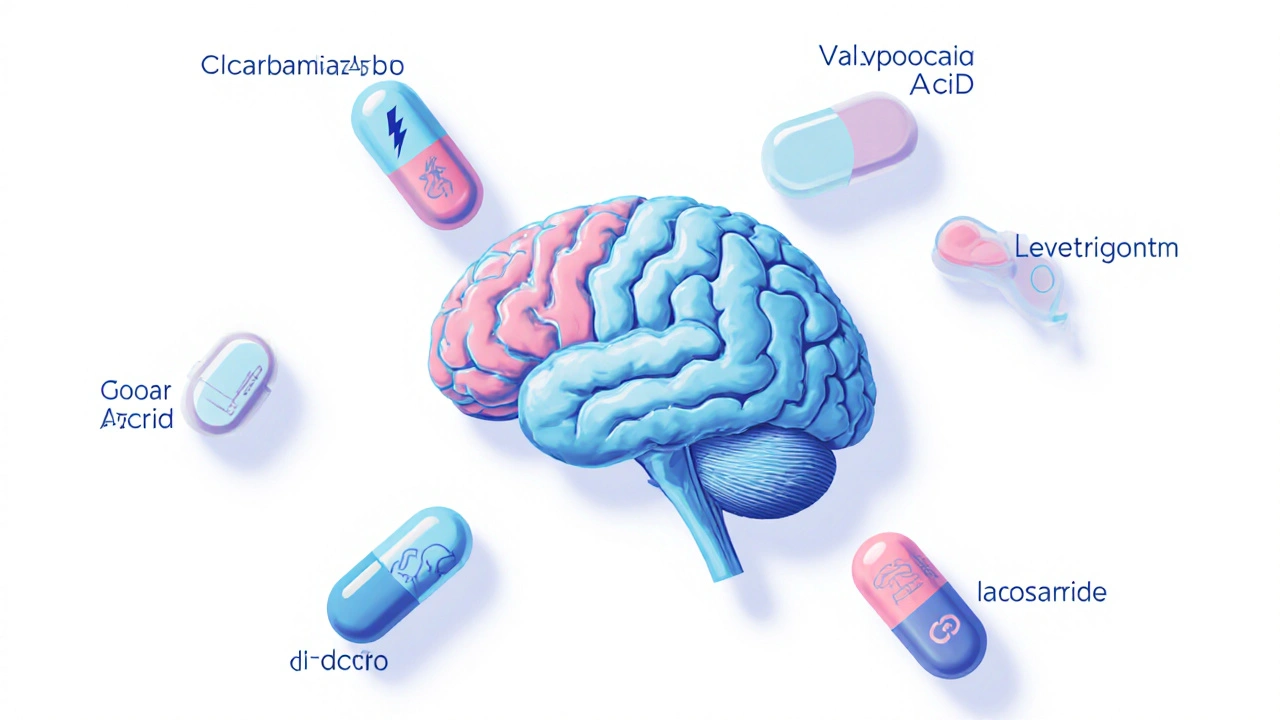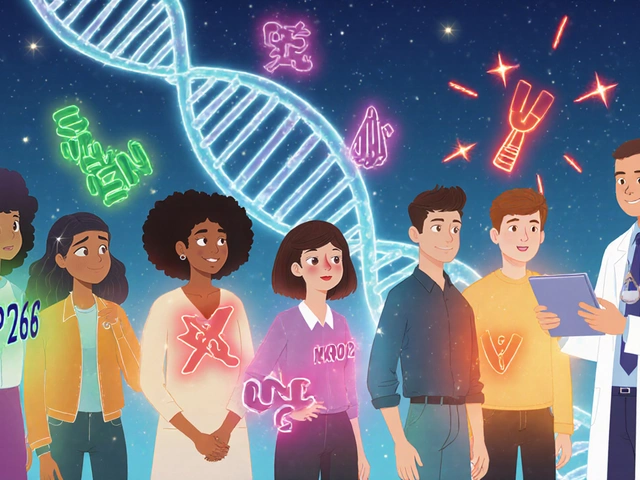
When it comes to controlling seizures, Dilantin is the brand name most patients hear first. Its generic name, phenytoin, belongs to the class of hydantoins that work by stabilising neuronal membranes and dampening excessive electrical activity. While Dilantin has helped generations of people with epilepsy, doctors now have a toolbox full of newer agents that may fit a patient’s lifestyle or health profile better. This article breaks down how Dilantin stacks up against its main competitors, so you can see whether a switch makes sense for you or a loved one.
Key Takeaways
- Dilantin is a strong enzyme inducer with many drug interactions, making it tricky for patients on multiple meds.
- Newer drugs like levetiracetam and lamotrigine have smoother side‑effect profiles and don’t require routine blood‑level monitoring.
- Choice often hinges on seizure type, comorbid conditions, and how tolerant a patient is of side effects.
- Cost and insurance coverage vary widely; generic phenytoin is cheap but some alternatives are now affordable as generics.
- Always discuss any switch with a neurologist; abrupt changes can provoke breakthrough seizures.
Why Compare Dilantin With Other Anticonvulsants?
Phenytoin has a narrow therapeutic window - blood levels between 10‑20 µg/mL are considered effective, but going higher quickly leads to toxicity. Its metabolism is fast‑track by the liver enzyme CYP2C9, meaning other drugs can either speed it up (causing loss of seizure control) or slow it down (causing side‑effects). Dilantin alternatives offer two big advantages: reduced interaction risk and fewer cosmetic side effects like gingival overgrowth.
Decision Criteria: What Matters Most?
- Seizure type covered - Some drugs are better for focal seizures, others for generalized.
- Side‑effect tolerance - Cosmetic, cognitive, mood changes differ.
- Drug‑interaction profile - Enzyme induction versus neutral metabolism.
- Monitoring needs - Blood‑level checks, liver function tests.
- Cost & insurance - Generic availability, co‑pay differences.
- Pregnancy safety - Teratogenic risk varies.
Top Alternatives Overview
Below are the most commonly prescribed alternatives, each introduced with microdata for quick reference.
Carbamazepine - a tricyclic anticonvulsant that blocks sodium channels much like phenytoin but with better efficacy for focal seizures. Valproic Acid - a broad‑spectrum agent useful for generalized seizures; works by increasing GABA levels. Levetiracetam - a novel agent that binds to synaptic vesicle protein SV2A, reducing neurotransmitter release. Lamotrigine - a sodium‑channel blocker with a gentle side‑effect profile, especially for mood stability. Topiramate - an agent that blocks sodium channels, enhances GABA, and inhibits glutamate receptors. Lacosamide - a newer drug that selectively enhances slow inactivation of sodium channels, useful for focal epilepsy.
Side‑Effect Comparison Table
| Drug | Mechanism | Common Side‑Effects | Interaction Risk | Monitoring |
|---|---|---|---|---|
| Dilantin (Phenytoin) | Blocks voltage‑gated Na⁺ channels (use‑dependent) | Gingival hyperplasia, hirsutism, cerebellar ataxia | High - strong CYP2C9 inducer | Serum level every 2‑4weeks after dose change |
| Carbamazepine | Na⁺ channel blocker, also depresses glutamate release | Dizziness, hyponatremia, rash (rare Stevens‑Johnson) | Moderate - induces CYP3A4 | Blood levels optional; liver enzymes regularly |
| Valproic Acid | Increases GABA, blocks Na⁺ channels | Weight gain, tremor, hepatotoxicity, teratogenicity | Low to moderate - affects protein binding | Serum level + liver function monthly |
| Levetiracetam | Modulates SV2A protein, reducing neurotransmitter release | Irritability, fatigue, mild rash | Very low - minimal CYP involvement | No routine blood work needed |
| Lamotrigine | Na⁺ channel blocker, also inhibits glutamate release | Skin rash (risk of SJS), dizziness | Low - limited enzyme induction | Serum level not required; slow titration essential |
| Topiramate | Blocks Na⁺ channels, enhances GABA, antagonises AMPA/kainate receptors | Kidney stones, cognitive slowing, paresthesia | Low - weak inducer of CYP2C19 | No routine level; monitor renal function |
| Lacosamide | Enhances slow inactivation of Na⁺ channels | Vertigo, nausea, PR‑interval prolongation | Low - minimal CYP effect | No routine monitoring needed |
When Dilantin Still Wins
Even with its drawbacks, phenytoin shines in a few niches:
- Acute seizure control - Intravenous phenytoin works fast in status epilepticus when other agents aren’t available.
- Cost‑sensitive settings - Generic tablets are among the cheapest AEDs on the market.
- Patients on enzyme‑inducing regimens - Sometimes clinicians need a drug that can reduce levels of other meds, such as certain antiretrovirals.
Practical Switch Checklist
If you or a clinician are thinking about moving away from Dilantin, follow this step‑by‑step plan to minimise seizure risk.
- Review current seizure type and frequency - note if they’re focal, generalized, or mixed.
- Identify comorbidities - liver disease, pregnancy, mood disorders, renal issues.
- Pick a target alternative based on the decision criteria above.
- Calculate a cross‑titration schedule: usually start the new drug at a low dose while keeping phenytoin at therapeutic level.
- Monitor for breakthrough seizures - keep a seizure diary for at least 4weeks.
- Gradually taper phenytoin over 2‑4weeks while checking serum levels weekly.
- Schedule follow‑up labs (liver enzymes, CBC) according to the new drug’s recommendations.
Cost Considerations in 2025
Australian PBS (Pharmaceutical Benefits Scheme) now lists generic phenytoin at $5 per 30‑tablet supply, while levetiracetam and lamotrigine have been added as generics costing roughly $30-$40 per month. Topiramate sits at $25, and lacosamide, being newer, remains around $80 unless covered by private insurance. When budgeting, factor in the need for regular blood tests with phenytoin (≈$30 per draw) - a cost that some newer agents avoid.

Pregnancy and Breast‑Feeding Guidance
Phenytoin is classified as a category D teratogen; it carries a 5‑10% risk of major congenital malformations, especially facial clefts. Valproic acid is even riskier (category X in many guidelines). Safer options for women planning pregnancy include lamotrigine and levetiracetam, both with lower teratogenic profiles. Always involve a maternal‑fetal medicine specialist when adjusting AEDs during pregnancy.
Real‑World Patient Stories (Illustrative)
Mark, 42, a software engineer, had been on Dilantin for 15years. He loved the cheap price but began to notice gum swelling and hair growth. After discussing with his neurologist, he switched to levetiracetam. Within a month his gum issues vanished, and his seizure frequency stayed the same. The only downside was mild irritability that settled after dose adjustment.
Sara, 19, diagnosed with juvenile myoclonic epilepsy, started on phenytoin but kept having morning seizures. Her doctor switched her to lamotrigine, titrating slowly over 6weeks. She now experiences no daytime seizures and reports better mood stability.
Bottom Line: Choose the Drug That Matches Your Life
There’s no one‑size‑fits‑all answer. Dilantin works well for many, especially where cost and rapid IV availability matter. However, if you’re juggling multiple prescriptions, caring about cosmetic side effects, or planning a pregnancy, one of the newer alternatives can offer a smoother ride. Talk with a neurologist, weigh the criteria, and use the switch checklist to transition safely.
Frequently Asked Questions
Can I stop Dilantin abruptly?
No. Stopping phenytoin suddenly can trigger status epilepticus. You need a gradual taper, usually over 2‑4weeks, while monitoring seizure activity and serum levels.
Which alternative has the fewest drug interactions?
Levetiracetam and lacosamide have the lowest interaction potential because they are not significant CYP inducers or inhibitors.
Do I need regular blood tests with the new drugs?
Most newer AEDs (levetiracetam, lamotrigine, lacosamide) do not require routine therapeutic drug monitoring. Valproic acid and topiramate may need occasional liver or renal checks.
Is phenytoin safe for children?
Phenytoin is approved for children over 2years, but the risk of gum overgrowth and bone issues is higher. Many pediatric neurologists prefer levetiracetam or topiramate for long‑term therapy.
How do I know which drug works best for my seizure type?
Focal seizures respond well to sodium‑channel blockers like phenytoin, carbamazepine, lamotrigine, and lacosamide. Generalized seizures often need broad‑spectrum agents such as valproic acid, levetiracetam, or topiramate. Your neurologist will match the drug profile to your EEG findings.







I stick with Dilantin because it’s cheap.
Reading through the comparison, I appreciate how you broke down the interaction risks and highlighted the newer options for people who need flexibility in their daily lives.
Dilantin has served generations, no doubt.
Yet the pharmaceutical landscape has evolved dramatically, offering alternatives that balance efficacy with tolerability.
The enzyme‑inducing nature of phenytoin creates a cascade of drug‑drug interactions that can compromise treatment plans.
Newer agents such as levetiracetam and lamotrigine sidestep many of these metabolic hurdles.
Moreover, the cosmetic side‑effects like gingival hyperplasia are not just aesthetic concerns; they affect oral health and confidence.
It is also critical to note that frequent serum level monitoring imposes both logistical and financial burdens on patients.
From a moral standpoint, prescribing a drug that demands relentless lab work when simpler options exist feels irresponsible.
The evidence supporting levetiracetam’s low interaction profile is robust, with multiple randomized trials confirming its safety.
Lamotrigine’s mood‑stabilizing properties add a layer of benefit for comorbid depression, a common companion of epilepsy.
Cost considerations have shifted, as generics of these newer drugs are now entering the market, narrowing the price gap.
For pregnant patients, the teratogenic risk of phenytoin is a serious red flag that should steer clinicians toward safer alternatives.
The checklists you provided for switching are practical, especially the emphasis on seizure diaries.
However, the recommended tapering schedule could be more flexible for patients with limited access to weekly labs.
In my view, a patient‑centered approach must weigh the intangible quality‑of‑life improvements alongside raw efficacy.
Ultimately, while Dilantin remains valuable in acute settings, the chronic management landscape favors drugs that enhance adherence without compromising safety.
Sure, the new drugs look shiny but remember every breakthrough comes with hidden caveats; long‑term data on levetiracetam is still accumulating, and rare behavioral side‑effects can emerge unnoticed.
Also, many clinicians are still more comfortable with the tried‑and‑true dosing of phenytoin, especially in low‑resource settings.
The cultural shift toward newer AEDs is encouraging, especially for patients tired of gum overgrowth 😃.
Exactly! 🎉 Newer meds like levetiracetam give you freedom from nasty blood draws and gum swelling, plus they’re often covered by insurance 😅.
When one examines the pharmacokinetic profile of phenytoin, it becomes evident that the drug’s non‑linear metabolism poses a substantial challenge for clinicians, especially considering the narrow therapeutic index; in contrast, agents such as lamotrigine exhibit linear kinetics, which simplifies dose adjustments, and levetiracetam, with its minimal protein binding, virtually eliminates the need for routine serum monitoring, thereby reducing both patient burden and healthcare costs, a factor that cannot be overstated in an era of value‑based care; furthermore, the adverse effect spectrum of phenytoin, which includes gingival hyperplasia, hirsutism, and cerebellar ataxia, often leads to non‑adherence, whereas newer agents tend to have more tolerable side‑effect profiles, and let’s not overlook the drug‑drug interaction potential, as phenytoin is a potent inducer of CYP enzymes, precipitating sub‑therapeutic levels of concomitant medications-a concern that is largely mitigated with the newer drugs, making them, in my opinion, the superior choice for chronic seizure management.